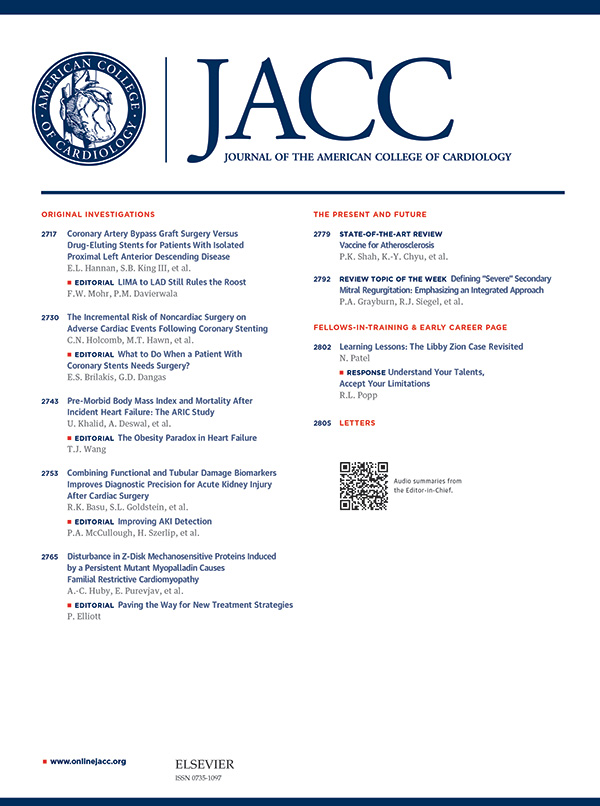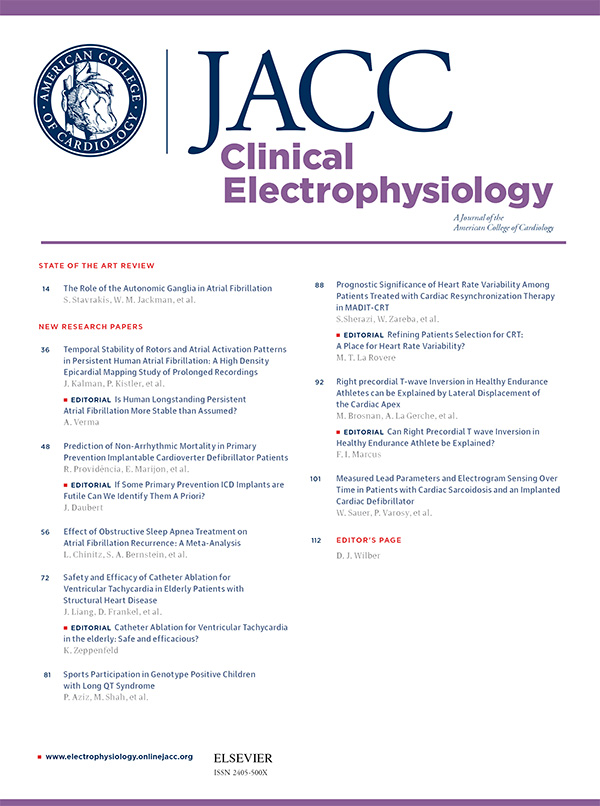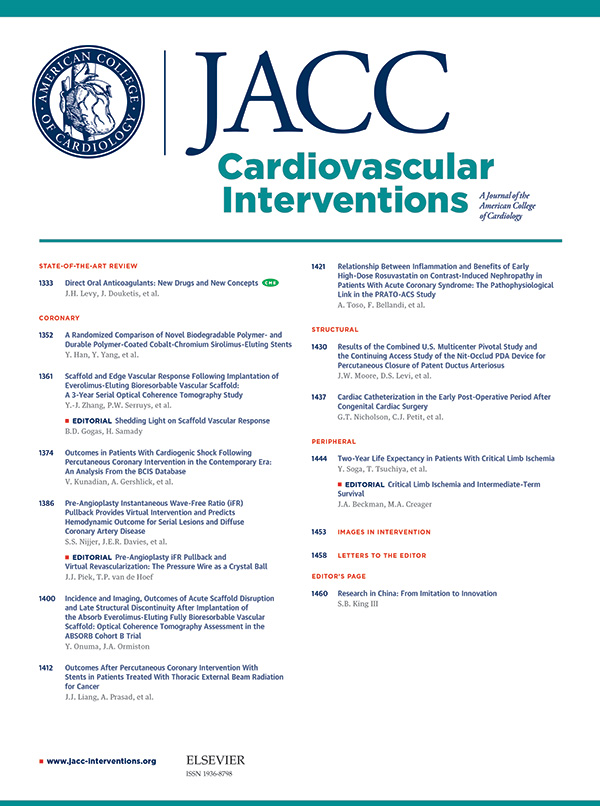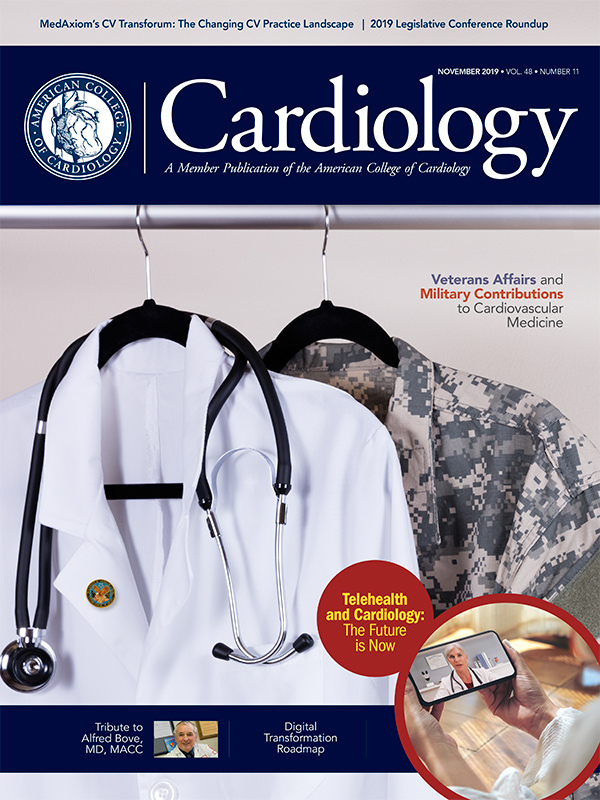JACC in a Flash
Featured topics and Editors' Picks from all of ACC's JACC Journals.
Childhood Secondhand Smoke Exposure Increases AFib Risk

Children of parents who smoke have a significantly increased chance of developing atrial fibrillation (AFib) later in life, according to findings published in the Journal of the American College of Cardiology.
Christopher A. Groh, MD, et al., used data from the Framingham Heart Study and Framingham Heart Offspring Study to analyze a total of 5,124 offspring cohort participants under 18 years between 1971 and 2014. Parents were evaluated by a physician every two to four years and children were evaluated every four to eight years.
Smoking was defined as more than one cigarette daily during the year prior to the study examination. Smoking status was calculated as packs per day; one pack represented 20 cigarettes. Secondhand smoke exposure was defined as the presence of a parent smoking more than zero packs per day.
Parental smoking status data were available for 2,816 (55 percent) children in the offspring cohort. Secondhand smoke exposure was experienced by 82 percent of children, and parental smoking status averaged 10 cigarettes per day.
Results showed that among the offspring cohort, 14.3 percent developed AFib over a follow-up period of 40.5 years. For each pack per day increase in parental smoking, children had an 18 percent increase in developing AFib.
Notably 17 percent of children whose parents smoked were more likely to smoke, suggesting another way parental smoking may predispose children to AFib. Previous investigations have confirmed that a smoking parent increases the likelihood of a child's chance of smoking later in life. Smoking cessation by parents may lead to a decreased smoking incidence for their children.
Study limitations include lack of available data for parental smoking status in nearly 45 percent of offspring participants, as well as variations in parental smoke exposure among children of separated, divorced, single parents or other smoking family members.
The demographic makeup of the Framingham Heart Study is predominantly white residing in one geographic area. However, the researchers stressed the importance of continued efforts toward smoking cessation and prevention of smoking initiation.
"Although some of the relationship between parental smoking and offspring AFib was explained by offspring smoking themselves, the results of this study indicate that secondhand smoke exposure in childhood is a risk factor for future development of AFib," said Alanna M. Chamberlain, PhD, MPH, in an accompanying editorial.
"This study boasts several unique advantages, including a rigorous methodology to ascertain incident diagnoses of AFib in the offspring, such as repeated evaluations with ECGs and routine surveillance for cardiovascular outcomes."
Groh CA, Vittinghoff E, Benjamin EJ, et al. J Am Coll Cardiol 2019;74:1658-64.
Sex-Specific hs-cTnI Assays Better Identify Women With Myocardial Injury

The use of a high-sensitivity cardiac troponin I (hs-cTnI) assay with sex-specific thresholds identified five-times as many additional women than men with myocardial injury in a recent study published in the Journal of the American College of Cardiology.
Kuan Ken Lee, MD, et al., performed a secondary analysis of the High-STEACS trial, which evaluated the impact on outcomes of incorporating hs-TnI in the evaluation of patients with suspected acute coronary syndrome (ACS).
A total of 48,282 consecutive patients (47 percent women) with suspected ACS were enrolled across 10 hospitals in Scotland in two phases: a validation phase of six months during which the contemporary TnI assay was used to guide clinical decisions, and an implementation phase of six to 24 months during which only results of the high-sensitivity assays were disclosed. Myocardial injury was defined as hs-TnI >99th percentile of 16 ng/L in women and 34 ng/L in men. The primary outcome was recurrent myocardial infarction (MI) or cardiovascular death at one year.
The majority of patients reclassified by the hs-cTnI assay and sex-specific thresholds were women (1,470 of 1,771 women [83 percent] vs. 301 of 1,771 men [17 percent]). Women were also more likely to be reclassified for all diagnoses: nonischemic myocardial injury and type 1 and type 2 MI.
Both women and men reclassified by the hs-cTnI assay were less likely to have myocardial ischemia on electrocardiography, but they had similar age, presenting symptoms and cardiovascular risk factors.
In women, no significant difference was seen for the primary outcome before (18 percent) and after (17 percent) using the assay. Women with myocardial injury remained significantly less likely than men to undergo coronary revascularization (15 vs. 34 percent) and to receive dual antiplatelet therapy (DAPT) (26 vs. 43 percent), statin therapy (16 vs. 26 percent) or other preventive therapies. Interestingly, the efficacy of coronary revascularization and DAPT to reduce the primary outcome was lower in women vs. men.
The same proportion of women and men are now identified as having myocardial injury, write the authors. Yet, despite recommendations from the Fourth Universal Definition of Myocardial Infarction, most health care systems worldwide use a single threshold to diagnose MI. Additionally, women remain half as likely as men to receive treatment for ACS even after implementation of the hs-cTnI assay and sex-specific thresholds.
In an editorial, Allan S. Jaffe, MD, FACC, and Sharonne N. Hayes, MD, FACC, write: "It is clear...simply improving diagnostic accuracy cannot remedy deeply embedded gender disparities in attitudes, practice, and outcomes. Simply put, if one does not act on the data, no diagnostic test will ever have additional worth."
Lee KK, Ferry AV, Anand A, et al. J Am Coll Cardiol 2019;74:2032-43.
Uninterrupted DOACs Safer than VKA During AFib Ablation

Uninterrupted direct oral anticoagulant (DOAC) therapy for catheter ablation in atrial fibrillation (AFib) appears to be safer than uninterrupted vitamin K antagonist (VKA) therapy due to a decreased rate of major bleeding events, according to a study published in JACC: Clinical Electrophysiology.
Jorge Romero, MD, FACC, et al., performed a systematic review and meta-analysis of randomized controlled trials comparing uninterrupted DOAC vs. uninterrupted VKA use in ablation procedures for AFib. The outcomes assessed included major bleeding, minor bleeding, thromboembolism, and postprocedure silent cerebral infarctions.
Six randomized clinical trials with a total of 2,256 participants (72.7 percent male; average age 61.3 years) were included. Uninterrupted dabigatran was used in 317 (14.1 percent) patients, rivaroxaban in 187 (8.3 percent), apixaban in 418 (18.5 percent) and edoxaban in 316 (14.0 percent) patients. The remaining patients (n=1,018; 45.1 percent) were on uninterrupted VKA.
Uninterrupted DOAC therapy was associated with a lower risk of major bleeding (2.3 vs. 5.2 percent; relative risk [RR], 0.45; 95 percent confidence interval [CI], 0.20-0.99) compared with uninterrupted VKA therapy. There was no identified difference in minor bleeding (13.9 vs. 13.7 percent; RR, 1.12; 95 percent CI, 0.87-1.43), thromboembolism (0.4 percent vs. 0.7 percent; RR, 0.75; 95 percent CI, 0.26-2.14) or postprocedural silent cerebral infarctions (16.3 vs. 15.4 percent; RR, 1.09; 95 percent CI, 0.80-1.49).
"Given our findings, we believe it is reasonable and beneficial to offer patients who need to undergo catheter ablation of AFib uninterrupted anticoagulation with DOACs as first-line therapy," the authors write. "DOACs are more convenient for both the patient and the physician, have fewer interactions with medications and food and do not require frequent blood testing to monitor the international normalized ratio."
Romero J, Cerrud-Rodriguez RC, Alviz I, et al. JACC Clin Electrophysiol 2019;Oct 2:[Epub ahead of print].
PVI Treatment and Risk of Radiation Injury

One in 14 patients undergoing peripheral endovascular intervention (PVI) using fluoroscopic imaging for the treatment of lower extremity peripheral artery disease suffer tissue injury from the treatment and have an increased risk of malignancy. Preprocedure assessments could enable the use of targeted treatments to reduce patient risk, according to a study published in JACC: Cardiovascular Interventions.
Andrew M. Goldsweig, MD, FACC, et al., collected data on 27,119 patients enrolled in ACC's PVI Registry from 2014 through 2017. Of those patients, 9,945 were excluded because of missing data or because the procedure was aborted or performed for acute limb ischemia. Of the 17,174 procedures performed at 73 sites analyzed, in 7 percent the patient dose-area product (DAP) exceeded 500 Gy cm2, the threshold for radiation-related adverse effects set by the National Council on Radiation Protection and Measurements.
When undergoing fluoroscopy-guided PVI procedures, patients are exposed to ionizing radiation. Long procedures and the need for repeat procedures can expose patients to significant radiation dosages, increasing their risk for tissue injury and malignancy. Researchers developed a 32-variable hierarchical multivariate linear regression model to identify independent predictors of increased DAP.
Because many of the 32 variables did not explain variability in DAP, a model based on seven of those variables was used, as they accounted for 90 percent of the variability. The seven predictors used in the reduced model, in order from greatest magnitude of effect, are lesion location, procedure duration, body mass index, male sex, bifurcation lesion, diabetes and hypertension.
"Preprocedural assessment of procedural radiation risks allows the adoption of radiation reduction strategies specifically targeting patients at increased risk for high radiation dosage," the researchers conclude. "Further research regarding such strategies is necessary to reduce patients' risks for tissue injury and malignancy from procedural radiation exposure."
Goldsweig AM, Kennedy KF, Abbott JD, et al. JACC Cardiovasc Interv 2019;12:473-80.
Ibrutinib Treatment May Lead to Cardiac Events

Cancer patients treated with ibrutinib may be at risk for severe and occasionally fatal cardiac events, according to study results published in the Journal of the American College of Cardiology.
Joe-Elie Salem, MD, PhD, et al., used VigiBase, the World Health Organization's global database of individual case safety reports (an international pharmacovigilance database), to perform a disproportionality analysis using reporting odds ratios (ROR) and information component (IC) to determine whether cardiovascular adverse drug reactions (CV-ADR) and CV-ADR deaths were associated with ibrutinib.
IC compares observed and expected values to find associations between drugs and ADRs using disproportionate Bayesian-reporting; an IC025 (lower end of the IC 9 percent credibility interval) >0 is significant.
The analysis identified 303 ibrutinib-associated cardiovascular deaths. Ibrutinib was associated with higher reporting of supraventricular arrhythmias (SVAs) (ROR, 23.1; 95 percent confidence interval [CI], 21.6-24.7; p<0.0001; IC025, 3.97); central nervous system hemorrhagic events (ROR, 3.7; 95 percent CI, 3.4-4.1; p<0.0001; IC025, 1.63); heart failure (HF) (ROR, 3.5; 95 percent CI, 3.1-3.8; p<0.0001; IC025, 1.46); VAs (ROR, 4.7; 95 percent CI, 3.7-5.9; p<0.0001; IC025, 0.96); conduction disorders (ROR, 3.5; 95 percent CI, 2.7-4.6; p<0.0001; IC025, 0.76); central nervous system ischemic events (ROR, 2.2; 95 percent CI, 2.0-2.5; p<0.0001; IC025, 0.73); and hypertension (ROR, 1.7; 95 percent CI, 1.5-1.9; p<0.0001; IC025, 0.4).
CV-ADR often occurred early after ibrutinib administration. CV-ADR were associated with fatalities that ranged from approximately 10 percent (SVAs and VAs) to approximately 20 percent (central nervous system events, HF and conduction disorders). SVAs were associated with HF in 11.9 percent of SVA cases; with central nervous system ischemic events in 4.2 percent; and with central nervous system hemorrhagic events in 3.4 percent. There were more deaths when SVA cases were associated with central nervous system hemorrhagic and/or ischemic events compared with their absence (28.8 vs. 9.7 percent; p<0.0001). HF cases were frequently associated with concurrent contributing conditions such as SVAs (31.4 percent) and, more rarely, hypertension (5 percent).
Conduction disorders were often associated with SVAs (22 percent). The median time from initiation of treatment with ibrutinib to onset for SVA was about two to three months and for hypertension was about four to five months. Whereas conduction disorders occurred mainly within the first month of initiating ibrutinib, contrasting with central nervous system events, HF and VA occurred around two to three months.
The authors write these finings should be considered for patient care and clinical trial design.
Salem JE, Manouchehri A, Bretagne M, et al. J Am Coll Cardiol 2019;74:1667-78.
Elevated CK-MB After PCI May Signal Increased Risk of Death

Elevated levels of creatine kinase-myocardial band (CK-MB) and cardiac troponin (cTn) are common after elective PCI with second-generation drug eluting stents (DES). An elevated CK-MB is associated with an increased risk of death at one year, according to findings published in JACC: Cardiovascular Interventions.
Hector M. Garcia-Garcia, MD, PhD, et al., performed a retrospective analysis of pooled patient-level data from five contemporary coronary stent trials and one large registry, encompassing 13,452 patients. All-cause mortality at one year of patients with stable angina and normal baseline biomarkers was compared between patients with and without elevations in cTn and CK-MB using different cutoff values. Survival analysis was stratified by peak biomarker levels using low threshold cutoffs (CK-MB five-times the upper limit of normal [ULN]; cTn 35-times ULN) and high cutoffs (CK-MB 10-times ULN; cTn 70-times ULN).
Most patients (97 percent) had a DES implanted. CK-MB and cTn were measured in most patients (11,613 and 10,639 patients, respectively). Both biomarkers were measured in 8,859 patients.
The mean age of the pooled cohort was 64 years and 73 percent were men; 31 percent had diabetes and 78 percent had one-vessel disease. After PCI, 23.9 percent of patients had elevated CK-MB and 68.4 percent had elevated cTn.
In the first year after PCI, 259 patients (1.9 percent) died. Univariable analyses revealed that patients with higher levels of CK-MB and cTn had significantly higher mortality. Notably, multivariable analyses revealed that an increased risk of death was associated only with an increase in postprocedure CK-MB ≥10-times ULN (hazard ratio [HR], 3.43; 95 percent confidence interval [CI], 1.81-6.49).
"cTn has become the cardiac biomarker of choice in the acute setting and has largely replaced CK-MB in all settings, such as periprocedural, in most clinical sites around the world," the authors write. "CK-MB is often no longer available as a routine clinical chemistry test at many institutions. As a result, cTn has or will become the default biomarker to assess periprocedural myocardial injury, except when core laboratory collection and testing of assays is implemented, a measure that is often costly and impractical."
Garcia-Garcia HM, McFadden EP, von Birgelen C, et al. JACC Cardiovasc Interv 2019;12:1954-62.
Clinical Topics: Arrhythmias and Clinical EP, Cardiovascular Care Team, Noninvasive Imaging, Prevention, Atrial Fibrillation/Supraventricular Arrhythmias, Smoking
Keywords: ACC Publications, Cardiology Magazine, Smoke, Smoke Inhalation Injury, Tobacco Smoke Pollution, Smoking, Atrial Fibrillation, Myocardial Infarction, Diagnostic Imaging
< Back to Listings

